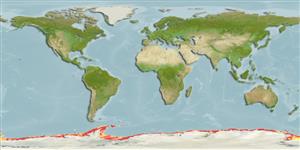Classification / Names
Common names from other countries
Issue
This species is placed in the genus Pseudotrematomus in Eschmeyer (CofF ver. Sep. 2011: Ref. 88002).
Main reference
Size / Weight / Age
Max length : 34.0 cm TL male/unsexed; (Ref. 5179)
Length at first maturity
Lm 22.0, range 19 - 26 cm
Environment
Marine; demersal; depth range 70 - 650 m (Ref. 26875)
Climate / Range
Polar, preferred -2°C (Ref. 107945); 60°S - 78°S
Distribution
Short description
Dorsal
spines
(total): 6 - 7;
Dorsal
soft rays
(total): 36-38;
Anal
spines: 0;
Anal
soft rays: 34 - 36;
Vertebrae: 54 - 57. Second dorsal-fin rays 0-3 more than anal-fin rays. Preopercular-mandibular canal with 10 pores; infraorbital canal with 6-8 pores; supra-orbital canal with 4 pores; coronal commissure with a single median pore; temporal canal with 5-6 pores; supratemporal canal complete wit 3 pores. Body and head almost entirely scaled, including snout, preorbitals, posterior part of maxilla, lower jaw, isthmus, branchiostegal membranes and proximal parts of branchiostegal rays.
Color: In alcohol, ground color buff, with a chequered pattern formed by staggered dark blotches along the dorsal, lateral and ventral parts of the body; ventral dark blotches may appear as short wavy horizontal dark marks. Snout, occipital region and sometimes interorbital area are dark.
IUCN Red List Status (Ref. 115185)
Threat to humans
Harmless
Human uses
Fisheries: commercial
Tools
Special reports
Download XML
Internet sources
Estimates of some properties based on models
Phylogenetic diversity index
PD50 = 0.5005 many relatives (e.g. carps) 0.5 - 2.0 few relatives (e.g. lungfishes)
Trophic Level
3.4 ±0.1 se; Based on diet studies.
Resilience
Medium, minimum population doubling time 1.4 - 4.4 years (Fec = 1,400-12,854)
Vulnerability
High vulnerability (61 of 100)
Price category
